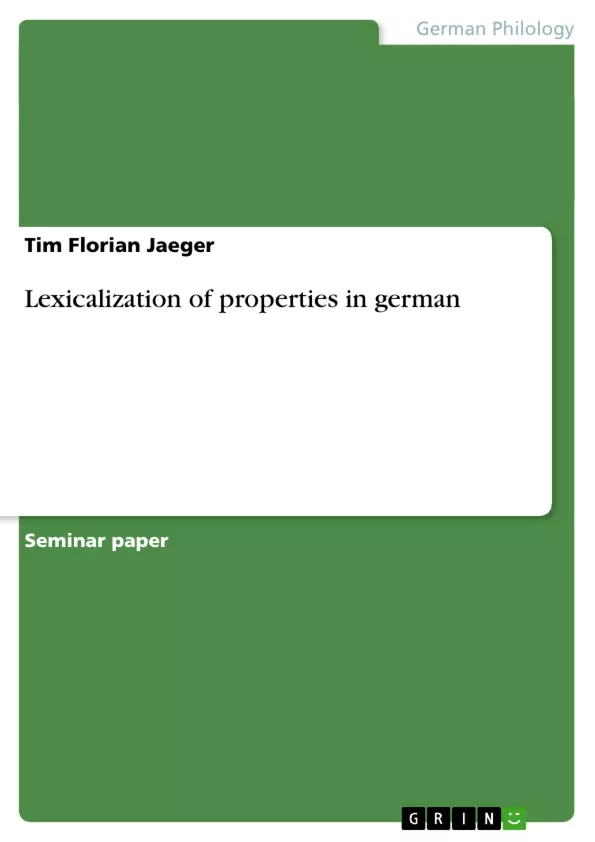In this squib, I describe the lexicalization patterns of properties in German. First, I show that German belongs to the set of languages with a open set of adjectives. Second, German is compatible with Stassen's (1997:169) hierarchy for the lexicalization of properties. Third, the discussed data argues for a slight revision of Haspelmath's (1993) classification of the German inchoative/causative alternation while at the same time confirming the tendencies observed by him.
Furthermore, I will show how the different types of properties as defined by Schaefer & Egbokhare (1993:160) and Stassen (1997:169) are lexicalized in German.
A note on translation: There are several cases where I had to chose between different possible translations. In those cases, I tried to find the intuitively more adequate translation. In cases, when all alternatives where equally acceptable, I decided for the one that seemed to be most frequent. This is probably a general problem in cross-linguistic comparisons like the one done by Haspelmath (1993) – choosing another translation can result in a different lexicalization pattern for that concept. For example, whether I decide that 'kind' should be translated nett or whether I decide to translate it as freundlich or lieb, etc. will result in a different relation between noun and adjective for the "concept" ... the adjective freundlich is derived the noun from Freude whereas the noun Nettigkeit is derived from the adjective nett.
Inhaltsverzeichnis (Table of Contents)
- Introduction
- Adjectives
- The data: property types and syntactic category
- SPEED
- PHYSICAL PROPERTY
- COLOR
- VALUE, AGE, FORM, DIMENSION
- MATERIAL, GENDER
- HUMAN PROPENSITY (permanent)
- HUMAN PROPENSITY (temporal)
- Property concepts: The generalizations
- About inchoative/causative
- SPEED
- DIMENSION
- PHYSICAL PROPERTY
- COLOR
- VALUE
- AGE
- FORM
- MATERIAL
- GENDER
- HUMAN PROPENSITY (permanent)
- HUMAN PROPENSITY (temporal)
Zielsetzung und Themenschwerpunkte (Objectives and Key Themes)
This squib examines the lexicalization patterns of properties in German. It analyzes how different types of properties, including SPEED, PHYSICAL PROPERTY, COLOR, VALUE, AGE, FORM, DIMENSION, MATERIAL, GENDER, and HUMAN PROPENSITY, are expressed through different grammatical categories in German.
- Lexicalization patterns of properties in German
- The open class of adjectives in German
- Stassen's hierarchy for lexicalization of properties
- Haspelmath's classification of the German inchoative/causative alternation
- Distribution of inchoative/causative alternations across different property classes
Zusammenfassung der Kapitel (Chapter Summaries)
- Introduction: This section introduces the topic of lexicalization patterns of properties in German and outlines the main objectives of the squib. It states that German has an open set of adjectives and is compatible with Stassen's hierarchy for lexicalization of properties. It also suggests a slight revision of Haspelmath's classification of the German inchoative/causative alternation.
- Adjectives: This section discusses the open class of adjectives in German and provides examples of derivational suffixes and prefixes used in adjectivization. It also mentions the productivity of compounding in forming new adjectives.
- The data: property types and syntactic category: This section presents tables summarizing how different types of properties are lexicalized in German. It analyzes each property type in terms of its typical lexicalization patterns, including the use of adjectives, nouns, verbs, and combinations of morphological elements.
- Property concepts: The generalizations: This section analyzes the data and draws generalizations about the lexicalization patterns of different property types in German. It highlights the preference for adjectives or nouns for most properties.
- About inchoative/causative: This section discusses the lexicalization patterns of the inchoative/causative alternation in German. It defines different types of alternations, including causative, anticausative, equipollent, supplative, and labile, and summarizes their distribution across different property classes.
Schlüsselwörter (Keywords)
The main keywords and focus topics of this text include lexicalization patterns, properties, adjectives, nouns, verbs, inchoative/causative alternation, German grammar, and cross-linguistic comparisons.
- Quote paper
- Tim Florian Jaeger (Author), 2002, Lexicalization of properties in german, Munich, GRIN Verlag, https://www.grin.com/document/45472



